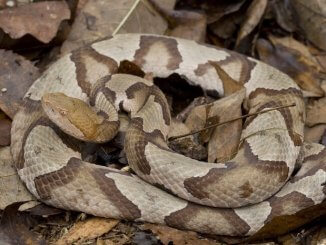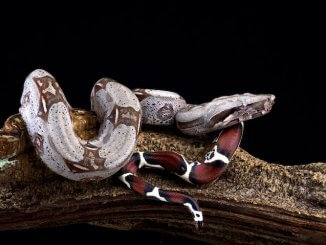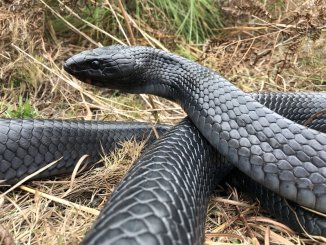The Dumeril’s boa is a medium-sized snake native to highly vegetated, dry forests in Madagascar. It has a thick-set body with a light to dark brown coloration, and can grow up to eight feet long.
Dumeril’s boas are easy to care for because they’re non-venomous and require minimal care. Many beginner reptile hobbyists confuse Dumeril’s boas with Madagascar ground boas because both snakes are ground-dwelling and endemic to Madagascar.
Dumeril’s Boa Overview
| Common Name(s): | Dumeril’s boa |
| Scientific Name: | Acrantophis dumerili |
| Natural Habitat: | Dry forests in Madagascar |
| Adult Size: | Up to eight feet long |
| Average Lifespan: | Up to 20 years |
| Diet: | Carnivore |
| Housing: | Large terrarium more than five feet long |
| Experience level: | Beginner to intermediate |
Origin
The Dumeril’s boa (Acrantophis dumerili) is native to dry forests in Southwest Madagascar. This species is not accustomed to the highly humid weather typically associated with rainforests in Madagascar.
Southwest Madagascar is moderately dry and certain areas are ripe with newly introduced tree species’, dry forests, and villages. The Dumeril’s boa lives in these areas, and isn’t frightened of human conflict or other ground-dwelling animals in its native area.
Dumeril’s boas are classified as “endangered” in the wild, which is one of the reasons why these snakes are a popular choice amongst reptile hobbyists. hese boas are also popular because of their non-venomous status, so if you get bitten by one, you’ll only be left with a scar.
Appearance and Behavior
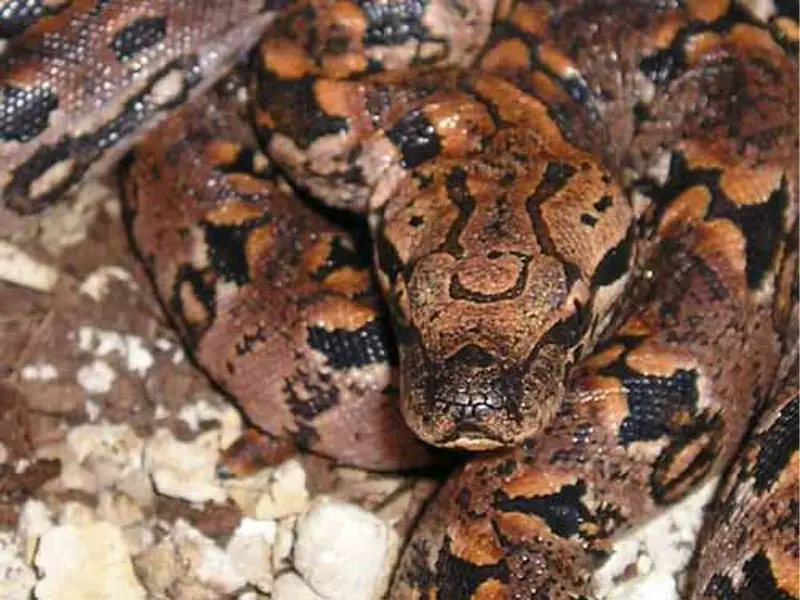
The Dumeril’s boa is a medium-sized snake with a stocky, thick-set body and a green, red, brown, and peach coloration that camouflages it in the wild. This snake is an ambush predator and will sit still and wait for prey. An adult Dumeril’s boa sleeps during the day and spends most of the night awake.
Males and females look similar at first glance. However, females are usually larger than males. These snakes are hard to sex, but there are some signs to look out for. Females have thin tales with a gradual taper, whereas males have thick tales with a sudden taper.
Size and Lifespan
Adult Dumeril’s boas grow up to eight feet long in captivity, although it’s common for wild snakes to reach 10 feet long. These snakes have a long life under the right captive conditions, and you can expect healthy snakes to live for up to 20 years or more.
Temperament
Dumeril’s boas are calm and peaceful snakes. These docile reptiles have peaceful dispositions, but some can become aggressive and agitated if you don’t respect their personal space.
Male Dumeril’s Boas are territorial around other male snakes, so housing your snake alone is the best way to prevent territorial behavior.
Experienced reptile keepers will find it easy to handle Dumeril’s Boas. If you’re a beginner hobbyist, you should take care while handling your snake. You should put your Dumeril’s Boa back into the terrarium if it starts to show signs of irritation because the snake may bite you if you overstep its boundaries.
Housing Dumeril’s Boas
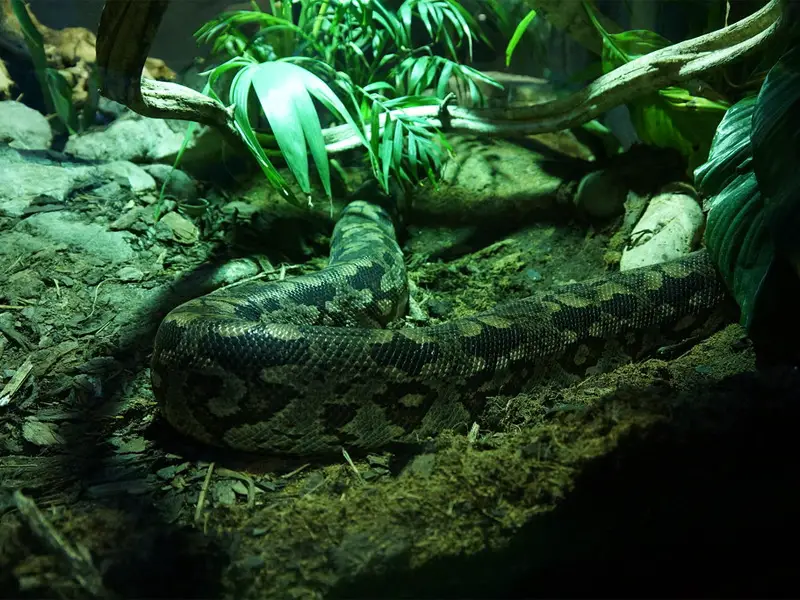
Dumeril’s boas have simple housing requirements. These snakes thrive in dry, highly vegetated regions of Madagascar. The Dumeril’s boa’s natural habitat includes trees and low-lying vegetation, and this boa often lives in and around villages and a few man-made buildings. You should replicate the Dumeril’s Boas natural habitat to keep your snake happy and healthy.
Invest in a large terrarium that is at least five feet long. Dumeril’s boas are terrestrial reptiles that require plenty of ground space to roam in, which makes the substrate more important than the terrarium’s vertical space.
Place a hide box in the terrarium to give your Dumeril’s boa a place to hide and rest. Scatter sticks of various sizes around the enclosure so that your snake can explore its enclosure and climb to higher than ground level.
Collect leaves that haven’t been chemically treated during fall and scatter them around the Dumeril’s boa’s enclosure. Snakes like exploring new scents and textures, and leaves are great seasonal toys for your snake.
Enclosure size
Keep your adult Dumeril’s boa in an enclosure that is five feet long, two feet wide, and one foot tall. Juvenile snakes can live in small two feet by two feet enclosures, but Dumeril’s boas are fast growers and will likely outgrow such an enclosure.
Large enclosures are hard to find. However, as long as the terrarium has a removable lid with air holes, and is made of hard plastic or clear glass, then the enclosure is suitable for Dumeril’s boas.
Lighting
You should use daytime heat lamps or fluorescent bulbs in your Dumeril’s boa’s terrarium. Dumeril’s boas don’t have specific lighting requirements, but you should provide them with a 12 hour day to night natural lighting cycle. You can install a timer to manage your snake’s light cycle and prevent disturbing their routine.
Temperature and Humidity
The Dumeril’s boa needs a basking spot and shaded area in the enclosure. You should keep the temperature in the shaded area constant and at 80°F. The basking spot should be located at the opposite end of the terrarium from the cool spot, and must stay between 85 and 87°F.
Use heating pads to keep the temperature in the basking spot constant, and measure the temperatures in the cool spot and basking spot daily.
Like most reptiles, Dumeril’s boas shed their skin. The humidity and moisture levels in the terrarium can help or hinder the shedding process, so monitoring these parameters daily is vital for the snake’s health.
Keep the humidity in the terrarium between 40 and 60 percent. Never let the humidity levels go higher than 60 percent. our snake could develop serious respiratory conditions from an overly humid environment.
Substrate and Decoration
The best substrate for a Dumeril’s boa terrarium is a DIY mix of 60% organic topsoil and 40% sand (ideally play sand). This is a cost-effective substrate option that is readily available at most reptile stores for a reasonable price.
Avoid lining the enclosure with a rough gravel substrate. Dumeril’s boas like to play in the substrate, and gravel can cause these snakes serious injury and will stop them from roaming freely in the enclosure.
Dumeril’s boas don’t need bedding, rocks, or caves in their enclosure. However, you should place a hide-box in a shaded corner of the enclosure, and a large water bowl for your snake to bathe and drink from.
Line the enclosure with leaves and sticks, and decorate the enclosure with small trees so that the Dumeril’s boa can explore different areas of the terrarium. The Dumeril’s boa is an intelligent snake and needs to be stimulated with activities, so make sure your snake has plenty of leaves to play with.
Cleaning
The best product to use to clean a Dumeril’s boa terrarium is vinegar diluted with water because vinegar is natural and non-toxic. Remove the substrate and any decorations, and wipe down the walls with the diluted vinegar and water solution on a monthly basis.
Spot-cleaning the terrarium is important and you should do this as and when you see dirt, leftover food, or soilage. A Dumeril’s boa’s enclosure can become dirty quickly, which will leave a distinct and unpleasant smell in and around the terrarium.
Never use bleach or other chemical cleaning products to clean a Dumeril’s boa enclosure. These chemicals are toxic and can kill your pet.
Dumeril’s Boa Care
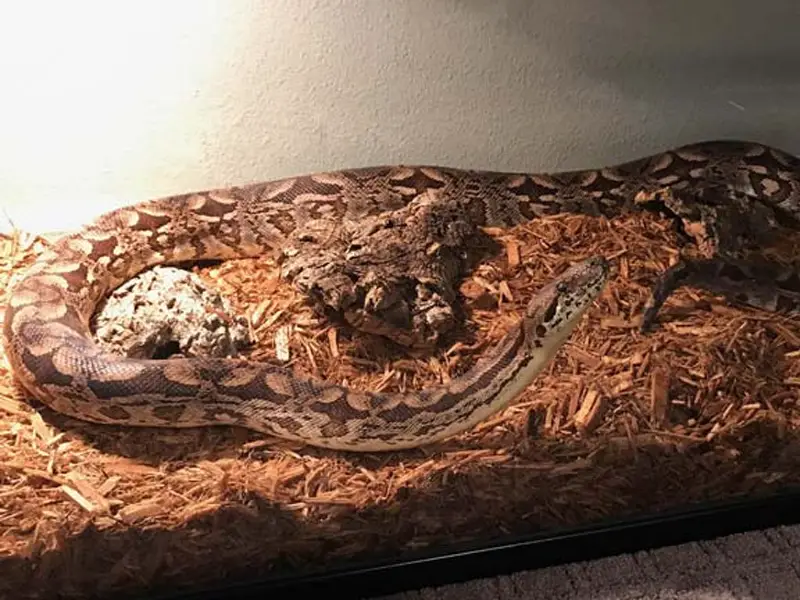
Dumeril’s boas are easy to care for and have minimal care needs. These boas are low-maintenance and only need a comfortable, large enclosure with access to food and water to thrive.
Food and Water
Dumeril’s boas eat mice, rats, chicks, small rabbits, gerbils, and hamsters. These snakes thrive on a varied diet. Feeding Dumeril’s boas according to their size and age is essential.
Juvenile Dumeril’s boas are still growing, which means they should eat every 14–20 days, whereas adults are no longer growing and should be fed every 21–28 days. You should feed hatchlings and snakes smaller than three feet long every seven days.
As a rule, Dumeril’s boas should eat food that is as wide as the widest part of the snake’s body. Prey that is smaller than this will leave the snake hungry, whereas large prey could be regurgitated and can leave your snake uncomfortable and agitated.
Handling
Dumeril’s boas can be handled, but you should handle your boa with care to avoid stressing or harming the snake. Here are some tips for handling Dumeril’s boas:
- Remove the snake from the enclosure using a hook, not your hand.
- Make sure you support the snake’s whole body weight, not just its head or tail.
- Never let your snake wrap itself around your neck. Dumeri’s boas are strong constricting snakes with a powerful grip.
- Keep the snake away from your face.
Overhandling will stress Dumeril’s boas, and can cause your snake serious health issues. Make sure your boa’s enclosure is located in a quiet room away from children and other pets.
Common Health Issues
Dumeril’s boas are prone to mites, obesity or sudden weight loss, and respiratory infections in captivity. Snakes are notoriously good at disguising illnesses, so you should be vigilant and perform a physical check of your snake on a weekly basis.
Below is how you can overcome some of the common health problems associated with keeping Dumeril’s boas.
- Mites — You can use human head lice creams to treat mites. However, there are reptile-specific products on the market too that are readily available in reptile stores and veterinaries.
- Weight loss — Weight loss can be a sign of serious health issues and requires urgent medical attention.
- Weight gain — Feed overweight Dumeril’s boas lean meats like birds, or feed your snake small prey.
- Respiratory infection (RI) — High humidity levels in the terrarium, or temperatures that are too cool can cause respiratory infections. Take your snake to the vet if you suspect your boa is suffering from a respiratory infection.
Keeping a record of your snake’s weight, eating habits, shedding, and general behavior will help you identify health issues before these conditions become a serious concern.
Breeding
Dumeril’s boas are easy to breed during the cool season. However, some snakes will breed during the warm season, and because of this, your snakes need to go through a brumation period. Look out for a small lump on the female’s underbelly. This lump indicates that the female is ovulating and that the breeding process is going well.
You shouldn’t feed Dumeril’s boas during breeding, and only feed females small prey during gestation to prevent digestion issues and discomfort. Follow the steps below if you want to breed your snakes.
- Start cooling the female’s enclosure in October. You should gradually reduce the temperature in your snake’s terrarium until the basking spot temperature is at 80°F.
- Keep the enclosure cool until late January. Start gradually heating the enclosure back up and leave the heating pad on overnight.
- Keep the male snake in the enclosure until you are confident that the female is pregnant.
- Females that are close to giving birth will shed their skin. The average gestation period is nine months.
- Remove the male once you notice the female begins to shed her skin. Male snakes will attack birthing females and the males will eat their young.
Dumeril’s boas give birth to live young, which is unusual, because most snakes lay eggs.
Choosing and Buying a Dumeril’s Boa
Dumeril’s boas vary in price, and a healthy snake costs r between $200 and $800.Shopping around and doing some background research into reputable snake breeders in your area is important.
Dumeril’s boas are readily available in pet stores and online. However, you should check the laws around importing these snakes in your area if you order online.
Buying Dumeril’s boas online is a risk because you could receive an unhealthy snake. Instead, go to your local reptile breeder or pet store and observe the snake for a while to make sure the snake is displaying healthy behavior.

